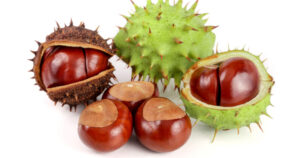Horse chestnut (Aesculus hippocastanum) is a tree native to the Balkan Peninsula but is now widely cultivated around the world. While it is commonly associated with its striking flowers and decorative appearance, extract of the chestnuts themselves also hold several potential health benefits. Horse chestnut contains a compound called aescin, which has been studied for its benefits. Let’s delve into these potential benefits and uses of horse chestnut and horse chestnut extract.
Exploring the Potential Benefits of Horse Chestnut

The raw seeds, bark, flowers, and leaves of horse chestnuts are not safe to eat as they contain a toxic component. Standardized horse chestnut seed extracts have this component removed and appear to be safe for short-term use. It is important to note that eating horse chestnuts is known to cause digestive problems, abdominal pain, nausea, vomiting, and throat irritation. Horse chestnuts are not to be confused with the aforementioned sweet chestnut. The following potential benefits are associated with horse chestnut extract.
1. Varicose Vein Relief

One of the most well-known uses of horse chestnut is for reducing the symptoms associated with varicose veins. Research suggests that horse chestnut seed extract may help decrease leg pain, swelling, and itching caused by this condition. It is believed to work by strengthening blood vessels and improving blood flow.
3. Anti-inflammatory Properties
Horse chestnut contains compounds known as aescin, which exhibit potent anti-inflammatory effects. These properties have been investigated for their potential to reduce inflammation in conditions like arthritis, tendonitis, and injuries. While more research is needed, horse chestnut might offer a natural alternative for managing inflammatory conditions. (3)





